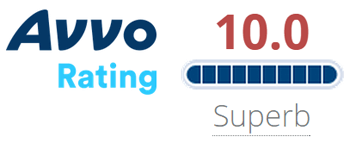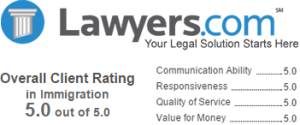
The Child Status Protection Act (CSPA) was enacted in order to keep immigrant families intact despite family-based and employment-based waiting times which can be long. It is meant to insure that sons and daughters can immigrate to the US together with their parents.
Prior to CSPA, once a child turned 21 years of age, he or she “aged-out” and was no longer able to immigrate (or adjust status) along with his or her parents. CSPA “freezes the age” of immediate relative children when their petitioning U.S. citizen parent submits a visa petition on their behalf; when a petitioning permanent resident parent naturalizes; or when a married son or daughter who has been petitioned by a U.S. citizen parent becomes divorced or widowed.
You can stay up-to-date with the waiting times in the Visa Bulletin by subscribing to our Free E-Mail Newsletter.
CSPA also creates a mathematical formula which allows the amount of time that a visa petition was pending to be subtracted from a child’s age at the time that the priority date becomes current.
Client Reviews

Life Saver
“After wasting thousands of dollars on other lawyers, Mr. Shusterman was life saver. I recommend him hands down!”
- Mukta Mohan, Buffalo, New York
Read More Reviews
Zoom Consultations Available!
Related Pages:
- CSPA Videos
- CSPA Formula
- CSPA Age Freeze
- CSPA Sought to Acquire
- DeOsorio “Automatic Conversion” and “Retention” Court Cases
- CSPA Federal Court Cases
The Child Status Protection Act is divided into the follow subtopics:
- CSPA Law and Related Articles
- Success Stories
- CSPA Cases Certified to the BIA
- Government Guidance
- Federal Court Decisions
- Administrative Decisions
- CSPA Resources
What happens if a child “ages-out” despite the mathematical formula?
CSPA provides relief for “aged-out” children in the form of the “automatic conversion” clause. However, on June 9, 2014, the Supreme Court deferred to the restrictive definition of this clause which was promulgated by the BIA.
CSPA also contains an “opt-out” clause which permits an unmarried adult son and daughter of a U.S. citizen to choose between the family-based 1st and 2B preference categories depending on which category allows him/her to reunite with their parent faster.
CSPA is applicable not only to persons who were sponsored for lawful permanent residence after the law took effect, but to many people who were sponsored for green cards prior to August 6, 2002.
On February 14, 2018, the US Court of Appeals for the 9th Circuit issued a decision which expanded the capacity of CSPA to keep immigrant families together. See CSPA: Rodriguez Tovar Decision Could Help Keep Families Together
Client Reviews

Professional and Knowledgeable Law Firm
“I’ve had a decade of experience with Mr. Shusterman’s law firm. I used them for my immigration needs from H1 to citizenship. It is safe to say this is one of the most competent, professional and knowledgeable law firms. If there is a firm that can handle any possible immigration case routine or otherwise; then this is it.”
- D. Chen, Phoenix, Arizona
Read More Reviews
Zoom Consultations Available!
Frequently Asked Questions
Q1. What is CSPA?
A. On August 6, 2002, President Bush signed the Child Status Protection Act into law. It will help prevent negative immigration consequences from occurring when a child turns 21 years of age before the USCIS or the State Department processes his application for permanent residence.
Q2. When did CSPA become effective?
A. It became effective as soon as it was signed into law on August 6, 2002.
Q3. Will the law apply to applications for permanent residence based on family-based petitions, employment-based categories and the visa lottery?
A. It applies to applications in all three categories.
Q4. What is the object of the law?
A. An unmarried child under 21 years of age who is eligible for permanent residence is entitled to certain benefits. For example, if his parent(s) are U.S. citizens, the child is considered an “immediate relative” and may obtain a green card without any numerical limitations. However, once he becomes 21 years of age, he no longer qualifies as an immediate relative, and must wait years to become a green card holder.
Similarly, a child who is immigrating along with his parents is no longer entitled to do so once he turns 21 years of age. When a child turns 21, and loses immigration benefits, this is commonly known as “aging-out”. The law seeks to prevent the unnecessary separation of parents and children due to aging-out.
Q5. Can a son or daughter over 21 years of age qualify as an immediate relative?
A. Yes. The following examples may be helpful:
- A father naturalizes as a U.S. citizen and petitions for his 20-year-old son. Formerly, the son had to obtain permanent residence prior to his 21st birthday. If he aged-out, his petition would automatically convert to the family-based first preference category (unmarried adult sons and daughters of U.S. citizens) where the waiting times are many years. Under CSPA, the child’s age is fixed on the day that the form I-130 visa petition is submitted on his behalf. Though he will be over 21 years of age when he obtains permanent residence, he is treated as a 20-year-old for immigration purposes.
- A mother who is a lawful permanent resident of the United States petitions for her 18-year-old daughter under the family-based 2A category (spouses and children of permanent residents). The next year, the mother applies for naturalization. By the time she naturalizes, her daughter is one week away from turning 21. There is no time for the daughter to complete the necessary application for permanent residence or for the USCIS to perform the necessary fingerprint and background checks and conduct an interview. Prior to CSPA, the daughter would be placed under the family-based first preference category. However, under the new law, her age is frozen as of the date that her mother naturalized. Since she was 20 at that time, she qualifies as an “immediate relative” and can adjust her status to permanent resident after her 21st birthday.
- A 19-year-old married son is petitioned by his U.S. citizen mother under the family-based 3rd preference category (married sons and daughters of U.S. citizens). A year later, the son and his wife obtain a divorce. The petition on his behalf automatically is converted to the immediate relative category. However, he does not apply for immigrant visa until three years later. Is it too late to apply as an immediate relative? No, under CSPA, his age is frozen as of the date of the termination of the marriage.
Q6. If the son or daughter cannot have his/her age frozen as an immediate relative, can he/she still qualify for a green card even after turning 21 years of age?
A. Here the calculation becomes a bit more complex. Again, let’s use an example to illustrate how the new law operates.
The family consists of a husband, wife and their two daughters, aged 18 and 15. The father is a programmer/analyst. His employer submits an application for an alien labor certification on his behalf. When the application is approved, the employer submits an EB-3 visa petition on behalf of the father. The petition is approved six months later, three months after the eldest child turns 21 years of age. Under the old law, the 21-year-old has aged out.
However, under CSPA, his age is fixed as of the date that a visa number becomes available “reduced by” the number of days that the EB-3 visa petition was pending. Since the petition was pending for six months, these six months must be subtracted from the child’s age (21 years and 3 months) when a visa number became available.
Therefore, the daughter’s age is fixed at 20 years and 9 months. This means that she is still considered a “child” for purposes of accompanying her parents in adjusting status to permanent residence. CSPA provides that she must “seek to acquire” permanent residence within one year of a visa number becoming available in order to take advantage of this provision of the law.
If the calculation had resulted in the daughter’s age being fixed at 21 or older, the new law provides that she would be automatically reclassified to an appropriate category, presumably family-based 2B, and that she retain her father’s original priority date. This would be the date that his employer submitted the labor certification application.
Q7. I was born in the Philippines in 1970. My father submitted a family-based 2B visa petition (unmarried adult son or daughter of a permanent resident) for me many years ago. Just before I was ready to immigrate to the U.S., my father became naturalized as a citizen of the United States. I was recently interviewed at the U.S. Embassy in Manila.
When I told them that my father had naturalized, they informed me that I would have to wait many more years to become a permanent resident. They said that his naturalization converted my petition from the 2B category to the 1st preference category. For Filipinos, the 1st preference category is more backlogged than the 2B category. What can I do?
A. Don’t blame your father. Hundreds, perhaps thousands, of Filipinos with petitions pending for their sons and daughters have naturalized, incorrectly assuming that this would shorten their waiting times to become permanent residents. In fact, this actually makes the waiting time much, much longer.
Now, under CSPA, you can submit a written statement to the USCIS stating that you do not wish to have your petition converted from the 2B category to the 1st preference category. If the conversion has already taken place, you can request that it be revoked.
Q8. Is there any provision of CSPA which affects asylees and refugees?
A. Yes. CSPA provides that a child who turns 21 years of age while his parent’s request for asylum or application for refugee status is pending may accompany or follow to join the parent once he is granted asylee/refugee status. CSPA also allows such a child to adjust status as an asylee/refugee.
Q9. When will the government issue regulations to implement CSPA?
A. Who knows? We are still waiting for regulations to be issued to implement certain provisions of the immigration laws enacted in 1996. Since certain provisions of the Child Status Protection Act are time-sensitive, you must act in a timely fashion in order to preserve your rights.
However, the USCIS and the State Department have issued numerous memos interpreting the law.
Q10. Is CSPA retroactive?
A. In some cases, yes.
It may apply to an alien who is the derivative beneficiary or any other beneficiary of a family-based (FB) or employment-based (EB) petition even if the petition was approved prior to the effective date of the law in some cases. See section 8 of CSPA.
CSPA also applies to FB and EB petitions and DV lottery applications pending on the date of the law’s enactment.
In simple English, even if a child appeared to have “aged-out” prior to August 6, 2002, but under the new law his “immigration age” is under 21, he may still be able to apply for adjustment of status or an immigrant visa for a limited period of time using his original priority date and preference category.
CSPA
SUCCESS STORIES – CSPA

- Keeping a Family United through CSPA
- Appealing an Incorrect CSPA Age Calculation
- Winning Twin CSPA Cases
- Reuniting a Family Using the CSPA
CSPA CASES CERTIFIED TO THE BIA
MATTER OF WANG
- BIA Denial of Motion to Reconsider (5-21-10)
- Motion To Reconsider And Request For En Banc Consideration (July 2009)
- BIA Decision (6-16-09)
- Notice of Certification and Memorandum for Certification to BIA (March 2008)
- Wang’s Brief to the BIA (April 2008)
- Government’s Supplemental Brief (August 2008)
- Wang’s Supplemental Brief (October 2008)
MATTER OF PATEL
- BIA Nonprecedent Decisions (1-11-11)
- Amicus Curiae Brief (January 2009)
- Patel’s Supplemental Brief (October 2008)
- Government’s Supplemental Brief (August 2008)
- Patel’s Brief to the BIA (June 2008)
- Notice of Certification to BIA, Notice of Action, Decision of USCIS’ California Service Center on I-130, Memorandum for Certification (June 2008)
GOVERNMENT GUIDANCE
USCIS Guidance
- USCIS Policy Manual – CSPA
- USCIS Updates Policy Guidance for the “Sought to Acquire” Requirement Under CSPA (8-24-23)
- USCIS Updates CSPA Age Calculation for Certain AOS Applicants (2-14-23)
- CSPA Policy Alert – USCIS (5-23-18)
- USCIS – Revised Guidance for CSPA (4-30-08)
- Revised Guidance for CSPA
- USCIS Memo: CSPA – Children of Asylees and Refugees (8-17-04)
- INS Memo Re: CSPA (9-20-02) – Replaced by USCIS Guidance of 4-30-08
State Department Guidance
- State Department Cable Re: CSPA (May 2003) – ALDAC #4
- State Department Cable Re: CSPA (May 2003) – ALDAC #3
- State Department Cable Re: CSPA (January 2003) – ALDAC #2
- State Department Cable Re: CSPA (August 2002) – ALDAC #1
- State Department Cable: Revised Interpretation of Age-Out Provision of PATRIOT Act (June 02)
FEDERAL COURT DECISIONS
- Rodriguez Tovar v. Sessions – U.S. Court of Appeals, 9th Circuit Finds that in Determining Whether a Beneficiary Remains a “Child” for AOS as an Immediate Relative, the CSPA Age, not the Biological Age, Controls (2-14-18)
- Robles-Tenorio v. Holder – U.S. Court of Appeals, 4th Circuit, Automatic Conversion – Unpublished (8-26-11)
- Midi v. Holder – U.S. Court of Appeals, 4th Circuit Upholds BIA’s Ruling That CSPA Does Not Apply to HRIFA Applicants (5-12-09)
- Ochoa-Amaya v. Gonzales (9th Circuit – 12-29-06)
- Baruelo v. Comfort No. 05-6659 (ND ILL – 12-29-06) (Unpublished District Court Opinion) – Appropriate Category is 2B
- Rodriguez v. Gonzales No. CV 04-8671 (CD CA – 5-31-06) (Unpublished District Court Opinion)
- Calix-Chavarria v. Attorney General of U.S. No. 05-3447, U.S. Court of Appeals, 3rd Circuit (5-12-06) – Not Precedential
- Gomes v. USCIS No. CV 05-3767 (CD CA – 3-22-06) (Unpublished District Court Opinion)
- Corea v. U.S. Attorney General No. 05-14479, U.S. Court of Appeals, 11th Circuit (3-15-06) – Unpublished
- Padash v. INS – U.S. Court of Appeals, 9th Circuit Rules On Meaning Of “Final Determination” under CSPA (2-19-04)
- Dandan v. Ashcroft – U.S. Court of Appeals, 7th Circuit Rules on Derivative Asylum Benefits under CSPA (8-11-03)
ADMINISTRATIVE DECISIONS
- Matter of Vasquez – Precedent BIA Decision re: “Sought to Acquire” (6-08-12)
- Matter of Zamora-Molina – Precedent BIA Decision re: Operation of the Opt-Out Provision (10-06-11)
- Matter of Azam – Non-Precedent BIA Decision re: Status of Children Who Aged-Out under CSPA (4-12-11)
- Matter of Murillo, Non-Precedent BIA Decision re: “Sought to Acquire” (10-06-10)
- Matter of Wang, 25 I&N Dec. 28 (BIA 2009) – Precedent Decision Regarding CSPA’s “Automatic Conversion” Clause (6-16-09)
- Matter of Avila-Perez, 24 I&N Dec. 78 (BIA 2007) – Precedent Decision Addresses Effective Date of CSPA (2-09-07)
- Matter of Garcia – Non-Precedent BIA Decision re: Status of Children Who Aged-Out under CSPA (6-16-06)
- Matter of Ki Na Kim – Non-Precedent BIA Decision Interpreting “Final Determination” (6-07-06)
- Matter of Ji Young Kim – Non-Precedent BIA Decision Interpreting “Sought to Acquire” (12-20-04)
CSPA RESOURCES
- USCIS Changes CSPA Age Calculation – CLINIC (10-2-23)
- Beware the Dangers of Naturalization for Child Beneficiaries – CLINIC (5-27-21)
- Child Status Protection Act – USCIS Policy Manual (2018)
- The Child Status Protection Act – American Immigration Council (2-05-15)
Summary of CSPA Applicability
| Migration Category | CSPA Age Determination | Sought to Acquire Requirement | Legal Authorities and Additional Guidance |
|---|---|---|---|
| Derivative Refugees | CSPA age is frozen on the date the principal refugee parent’s Form I-590 is filed (the date of the parent’s interview) | Not Applicable | See INA 207(c)(2)(B) and INA 209(a)(1). See Part L, Refugee Adjustment, Chapter 2, Eligibility Requirements, Section F, Special Considerations for Refugee Adjustment of Status Applicants, Subsection 2, Child Status Protection Act Provisions [7 USCIS-PM L.2(F)(2)]. |
| Derivative Asylees | CSPA age is frozen on the date the principal asylee parent’s Form I-589 is filed. | Not Applicable | See INA 208(b)(3)(B). See Part M, Asylee Adjustment, Chapter 2, Eligibility Requirements, Section C, Derivative Asylee Continues to be the Spouse of Child of the Principal Asylee, Subsection 2, Derivative Asylees Ineligible for Adjustment of Status . |
| Immediate Relatives (including VAWA) | CSPA age is frozen on the date the Form I-130 or Form I-360 is filed. | Not Applicable | See INA 201(f). See AFM 21.2(e), The Child Status Protection Act of 2002. |
| Family-Sponsored Preference Principals and Derivatives (including VAWA) [43] | CSPA age is calculated by subtracting the number of days the petition was pending from the applicant’s age on the date an immigrant visa becomes available to the applicant. | Applicant must seek to acquire lawful permanent residence within 1 year of the visa becoming available. | See INA 203(h). See AFM 21.2(e), The Child Status Protection Act of 2002. |
| Employment-Based Preference Derivatives | CSPA age is calculated by subtracting the number of days the petition was pending from the applicant’s age on the date an immigrant visa becomes available to the applicant. | Applicant must seek to acquire lawful permanent residence within 1 year of the visa becoming available. | See INA 203(h). |
| Diversity Immigrant Visa Derivatives | CSPA age is calculated by subtracting the number of days the petition was pending from the applicant’s age on the date an immigrant visa becomes available to the applicant. | Applicant must seek to acquire lawful permanent residence within 1 year of the visa becoming available. | See INA 203(h). |








